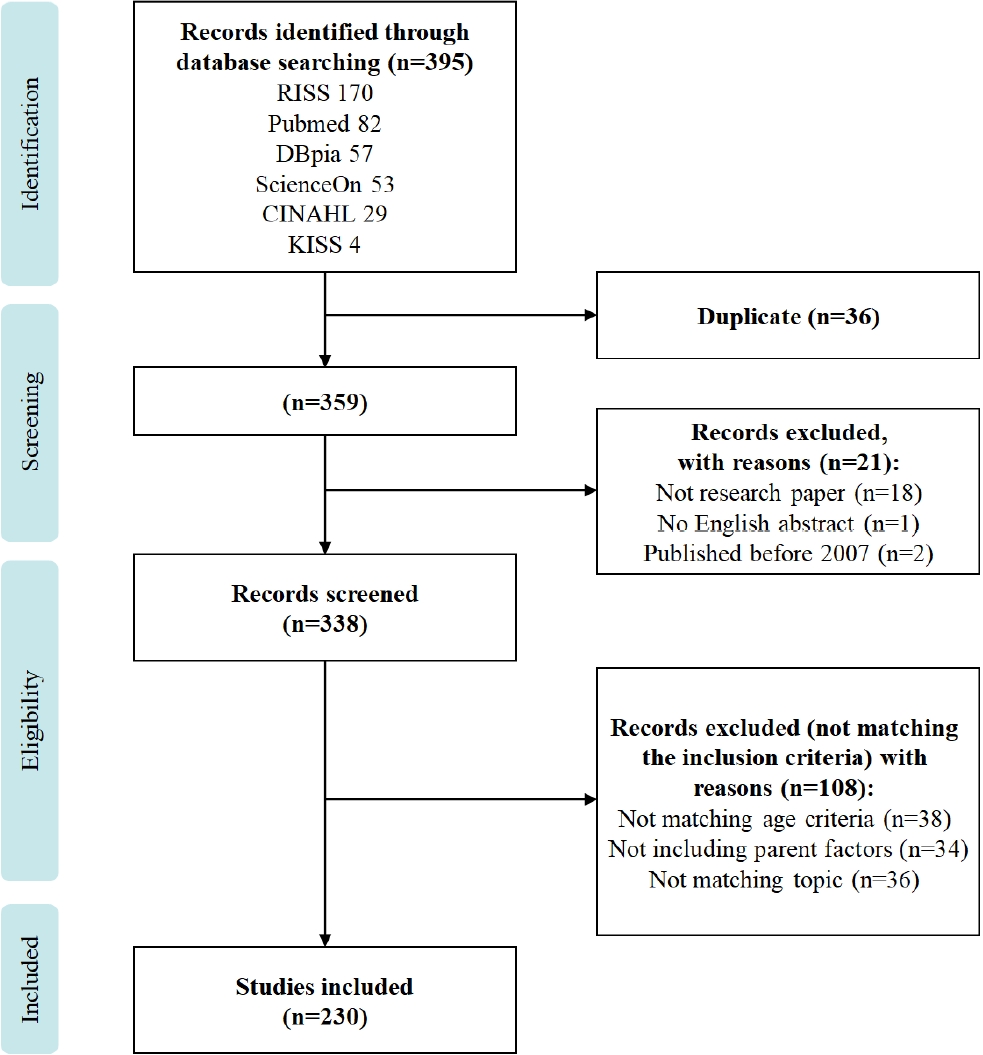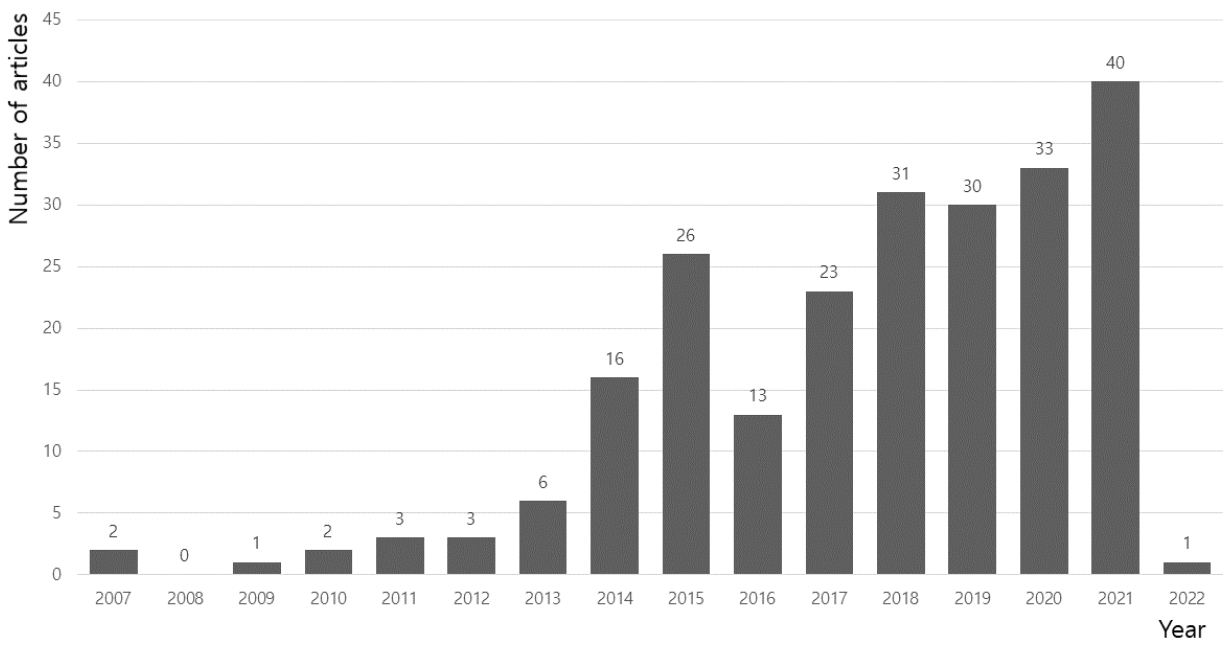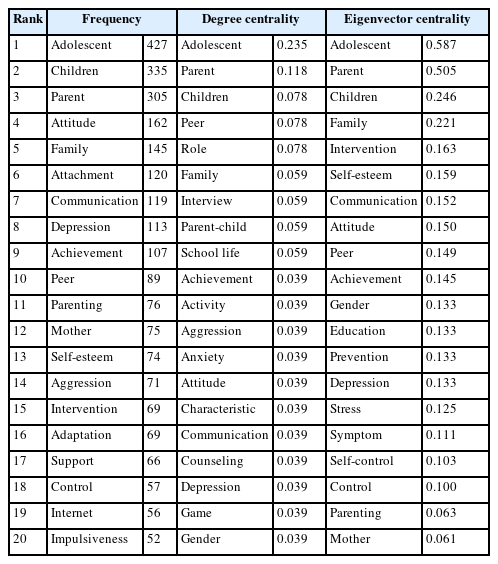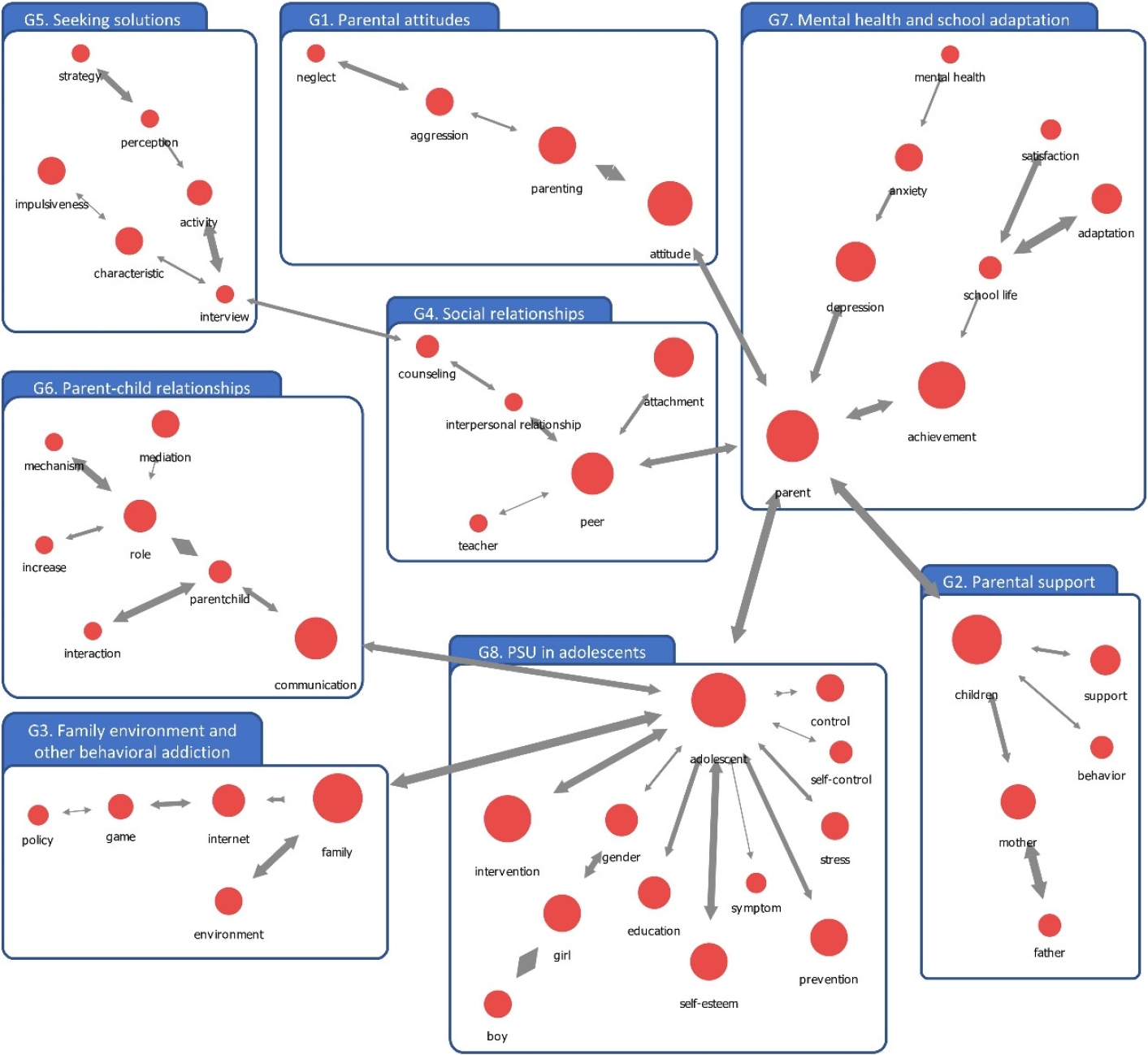Research trends related to problematic smartphone use among school-age children including parental factors: a text network analysis
Article information
Abstract
Purpose
This study aimed to identify the main keywords and research topics used in research on problematic smartphone use (PSU) among children (6-12 years old), including parental factors.
Methods
The publication period for the literature was set from January 2007 to January 2022, as smartphones were first released in 2007. In total, 395 articles were identified, 230 of which were included in the final analysis. Text network analysis was performed using NetMiner 4.5.
Results
Research on this topic has steadily increased since 2007, with 40 papers published in 2021. Eight main research topics were derived: group 1, parental attitudes; group 2, children's PSU behavior and parental support; group 3, family environment and behavioral addiction; group 4, social relationships; group 5, seeking solutions; group 6, parent-child relationships; group 7, children's mental health and school adaptation; and group 8, PSU in adolescents.
Conclusion
Parental factors related to PSU have been studied in various aspects. However, more active research on school-age children's PSU needs to be conducted due to the paucity of research in this population compared to studies conducted among adolescents. The results of this study provide useful data for selecting research topics in the field of PSU.
INTRODUCTION
Smartphones are indispensable in modern society because people can install applications to carry out various convenient functions at any time and place [1,2]. Children are no exception, as children use smartphones at younger ages and for longer periods, and their smartphone dependency rate is high [3]. During the coronavirus disease 2019 (COVID-19) era, the time spent using smartphones increased because outdoor activities decreased and non-face-to-face classes increased [4]. This phenomenon has also been observed in national statistics. The proportion of adults with smartphone overdependence increased from 20.0% in 2019 to 24.2% in 2021 [5]. During the same period, that of children increased significantly from 20.6% to 28.4% [5], suggesting that the problem is more serious for children than for other age groups.
The prevalence of problematic smartphone use (PSU) is higher in adolescence than in other age groups, but school age is also important. School age is the period when the scope of children's activities expands, and many parents buy smartphones for their children for the first time. Many parents buy smartphones for their school-age children because parents believe that having a smartphone makes it easy to contact or pick up their children, enables their children to interact with peers, facilitates various positive experiences, and aids in learning [6]. However, children's early use of smartphones can cause problems, such as increased sedentary behavior, altered brain development, impaired social skill development, exposure to harmful and illegal content, and addiction to technology at an early age [7,8]. Therefore, school-age children should receive guidance on how to use a smartphone properly when they first own a smartphone.
Children are strongly influenced by their parents in various aspects of development, such as communication, self-regulation, and physical and mental health, because they grow up in the home environment created by their parents [9]. Previous studies have revealed that many parental factors affect children's PSU, including double-income families, parental support, and parental attitudes [5,10,11]. Parents can also intervene in various ways to ensure that their children use their smartphones appropriately [12]. Parental guidance is effective in school-age children because school-aged children are highly dependent on their parents, unlike adolescents, who want psychological independence from their parents [13,14]. Therefore, it is necessary to identify the parental factors that affect children's PSU.
Many researchers have been interested in children's PSU since smartphones were first released in 2007, and a considerable amount of research has been conducted. In the COVID-19 era, digital technology has deeply penetrated many aspects of our lives, including education, media, entertainment, healthcare, manufacturing, retail, food services, banking insurance, travel, and tourism [15], making it impossible for people to live without their smartphones. Therefore, research on PSU has entered a new phase that requires researchers to focus on how to encourage children to use smartphones properly, rather than focusing on reducing usage as a goal in its own right. Therefore, it is necessary to expand this area of research with new insights by analyzing the trends and concepts in research to date [16]. Text network analysis is a method for understanding research trends more richly by schematizing the relationships between topics and concepts of interest in many papers published in academic journals, utilizing technology that makes it possible to analyze a large number of papers [17,18]. Cohesion analysis is also used to extract sub-theme groups [19]. As a pre-stage of developing an intervention program for PSU among school-age children and their parents, this study explored research trends regarding parents' influence on children's PSU through text network analysis and attempted to identify key themes and main semantic structures. This is one of the first studies using text network analysis to identify research trends on PSU in children. We intend to provide valuable data for establishing future directions of research on children's smartphone dependence.
This study aims to identify the main keywords and research topics in the study of PSU among school-age children, including parental factors.
METHODS
Ethics statement: The Institutional Review Board (IRB) of the Jeonbuk National University (No. NON2022-004-001) reviewed this study. The committee decided that this study was an exempt research study.
1. Study Design
This descriptive study aimed to analyze the major research trends on parental factors related to PSU among school-age children using text network analysis. This study followed the criteria of the PRISMA-NMA (Network Meta-Analyses) checklist [20].
2. Data Collection and the Research Process
1) Search method
This study analyzed research papers related to PSU among school-age children that included parental factors. The publication period of the literature was set from January 2007 to January 2022 because smartphones were first released in 2007. A librarian assisted in the search for papers. The search methods are described in detail below:
(1) Sources that were searched
Domestic: Research Information Service System (RISS), Korean Studies Information Service System (KISS), DBpia, ScienceON
International: Pubmed, Cumulative Index to Nursing and Allied Health Literature (CINAHL)
(2) Search strategy
('child*' OR 'youth' OR 'teenager' OR 'elementary school') AND ('smartphone' OR 'mobile phone' OR 'cell* phone' OR 'digital device' OR 'smart media') AND ('addiction' OR 'overuse' OR 'dependency' OR 'excessive use' OR 'problematic') AND ('parents' OR 'fathers' OR 'mothers')
2) Selection of research papers
Two researchers independently searched the literature and compared the search results to ensure consistency and accuracy in selecting the papers to be included in the analysis. The data collection and selection process are summarized in Figure 1. The inclusion and exclusion criteria were as follows:
ㆍ Literature published from January 2007 to January 2022
ㆍ Literature on the topic of PSU
ㆍ Study participants including school-age children (6-12 years old)
ㆍ Parent factors among the study variables
ㆍ Papers published in English or Korean
ㆍ Literature published outside the publication period
ㆍ A research topic other than PSU
ㆍ Literature not including parental factors
ㆍ Books or conference abstracts
3) Data preprocessing
The words in the selected 230 English abstracts were filtered and refined using the natural language processing function of the NetMiner program (ver. 4.5; Cyram Inc.). Based on the extracted words, a thesaurus, a defined word dictionary, and an exception word dictionary were used to extract meaningful keywords. Nouns that consisted of two or more words, such as proper nouns, compound nouns, and abbreviations (e.g., "parental role" or "social relationship"), were registered in the defined word dictionary. Several words with similar meanings were registered in the thesaurus to be extracted as one word (e.g., "mobile phone," "cellular phone," and "cell phone" were categorized under the representative word "smartphone"). Common words, statistical terms, and words that were not relevant to the research purpose were registered in the exception word dictionary to be excluded from the analysis (e.g., "aim," "background," and "Pearson"). Additionally, "smartphone" and "addiction" were excluded to prevent other meaningful concepts from not receiving adequate exposure, as these two words were search terms that were included in all abstracts and may have been expressed much more than other concepts.
To clearly identify the main phenomenon, it is necessary to analyze repeatedly appearing keywords in text network analysis [21]. Therefore, words consisting of one letter or appearing only once in the data were excluded using the query function of the NetMiner program, after which 676 words were finally extracted. Additionally, if a word appears multiple times in one abstract or a lengthy abstract, the word may be overestimated as an extensively studied subject. To prevent overestimation and ascertain the number of times a word appeared in publications, the two-mode degree (which refers to the number of links between two nodes in a network consisting of two characteristics, such as "word" and "article" in this study [22]) was calculated in the word-article network, and node attributes were added in the word network.
4) Network generation and filtering
A word-to-article (two-mode) network was transformed into a word-to-word (one-mode) network using the comembership and correlation-inner product options. As a result, 1,085 links were generated. The pathfinder network (PFnet) is a network generated by removing paths that violate the triangle inequality with all weighted links created, clearly revealing the overall structure, as well as the detailed structure of the network [23]. Therefore, in this study, the network was visualized after link filtering using PFnet for more meaningful analysis.
3. Centrality and Cohesion Analysis
Centrality analysis was performed to identify core themes in the overall network structure. Centrality is an indicator of the status of each node in a network. In this study, degree centrality and eigenvector centrality were analyzed. Degree centrality is the simplest centrality measure for a node in a network; it counts the total number of connections a node has, and a higher degree centrality means that a node is centrally located within the network. Eigenvector centrality is an extension of degree centrality, and it is increased by having connections to other nodes that are themselves important [24].
In the next step, cohesion analysis was conducted to categorize the topics and concepts that the research papers were trying to convey. Cohesive subgroups are sets of concepts that are strongly, directly, and frequently studied together. In this study, community structure analysis was performed to optimize modularity among hard clusters, which classifies groups by allowing one node to belong to only one group [25]. Typically, a network with a modularity between 0.3 and 0.7 has a strong community structure [26]. In this study, the highest modularity was 0.714.
RESULTS
1. Publishing Trends in Problematic Smartphone Use among School-Age Children and Their Parents
Research on PSU among school-age children and their parents has steadily increased from 2007, when the first research paper was published, to 2021, when 40 papers were published (Figure 2).
2. Comparison of Core Keywords in Problematic Smartphone Use Research
Table 1 presents the top 20 keywords in terms of frequency, degree centrality, and eigenvector centrality. The core keywords that appeared in all three categories were "adolescent", "children", "parent", "attitude", "family", "communication", "depression", and "peer". The core keywords of degree centrality only were "role", "interview", "parent-child", "school life", "activity", "anxiety", "characteristic", "counseling", and "game", and those for eigenvector centrality only were "education", "prevention", "stress", "symptom", and "self-control".
3. Subject Group Analysis through Network Schematization
Eight groups were derived as a result of schematizing the network to understand the structures of research trends on PSU (Figure 3). Group 1 dealt with parental attitudes (attitudes, parenting, neglect); group 2, children's PSU behavior and parental support (child, support, mother, father); group 3, family environment and behavioral addiction (family, environment, internet, game, policy); group 4, social relationships (peers, interpersonal relationships, teachers); group 5, seeking solutions (interviews, characteristics, activities, strategies); group 6, parent-child relationships (communication, parentchild, interaction); group 7, children's mental health and school adaptation (parents, mental health, school life); and group 8, PSU in adolescents (adolescent, interventions, gender, self-esteem, control).
DISCUSSION
This study used text network analysis to identify research trends in PSU among school-age children, including parental factors. PSU research has increased since 2007, when smartphones were introduced for the first time in the world. Because of the COVID-19 pandemic, school-age children who have experienced self-quarantine or non-face-to-face classes have a higher risk of PSU [5]; therefore, research on PSU is expected to become more important in the future.
The main research content related to parental factors is as follows. In the centrality analysis, the main keywords related to parents were "parent-child," "parenting," "mother," and "family." The "role" and "control" keywords related to parental roles appeared at the top. In the cohesion analysis, a total of four keyword groups were derived in relation to the parental factors. Group 1 (parental attitudes) consisted of studies on parenting attitudes, and it was found that "neglect," a negative parenting attitude, and "aggression," a characteristic of children, were extensively studied. Group 2 (parental support) consisted of studies that provided necessary support for children and parents regarding problem behaviors related to children's smartphone use. Group 3 (family environment and other behavioral addictions) consisted of studies on the relationship between smartphone dependence, internet use, game addiction, and family environment. Group 6 (parent-child relationships) consisted of studies on parental control of children's smartphone use, parent-child relationships, and communication. Various methods exist for parental mediation of children's smartphone use, but detailed keywords related to parental control methods have not been discussed in detail.
When exposed to a challenging online social environment without proper guidance, children are easily harmed by the internet, showing personality and mental health deviations [27]. Repeated exposure to smartphones and media increases the risk of becoming addicted to smartphones [28]. Parents have a substantial influence on their children during school age, so more research on parental mediation to control their children's problematic use needs to be conducted. According to previous studies, technological control using applications has limitations [29], and if parental control is too weak or too strong, it can intensify children's aggression and cause parent-child conflict [30]. Therefore, more specific studies related to effective parental mediation should be conducted to help parents control smartphone addiction without harming the parent-child relationship.
The "child" keyword did not form a group; instead, it was a node in group 2, which was one of the parent-related keyword groups. In contrast, the keyword "adolescent" formed a large component of group 8, even though studies that only targeted adolescents were excluded. One of the main purposes of this study was to identify trends in research on PSU in school-age children, but most previous studies included were conducted on adolescents, and school-age children accounted for a portion of the research participants. This explains why a "child" keyword group was not formed.
As mentioned earlier, the "adolescent" node showed more importance than the "child" node in the network map. In the cohesion analysis, research on adolescents was conducted on a greater variety of topics (group 8) than research on schoolage children (group 2). This is because the main target of research on PSU was adolescents, who have the highest dependence rate. Self-esteem and self-control are known to be the most important protective factors against PSU [31], and the network map of this study showed that these topics were mainly examined in relation to adolescents. Among the papers analyzed in this study, only one self-control study and five self-esteem studies were conducted on school-age children. Additionally, children with PSU usually have low self-efficacy because they repeatedly experience the inability to control their smartphone use [32]. Self-efficacy is an important factor in self-health behavior, and it is essential for children to control their smartphone use on their own. However, self-efficacy was not a key factor in this study. In future studies, it is necessary to conduct more active research on the protective factors of smartphone dependence in school-age children, such as self-control, self-esteem, and self-efficacy. In particular, future studies should investigate how parents can enhance these factors in children.
Since this study targeted school-age children, their parents, and adolescents, three groups of keywords were additionally derived: group 4, social relationships; group 5, seeking solutions; and group 7, mental health and school adaptation. Group 4 included studies on peer attachment and interpersonal relationships, and group 7 included studies on school adaptation and mental health. However, it should be noted that the keyword "teachers" did not appear. Teachers have a large impact on children and adolescents' school-life adaptation, and inadequate guidance from teachers can cause adverse psychological effects such as aggression, social withdrawal, and depression in children and adolescents [33]. In addition, teacher support is a crucial predictor and protective factor for PSU [34]. Since schools are the most effective places for group education to develop healthy smartphone use habits, more studies related to schools and teachers need to be conducted. In group 5, qualitative studies appeared to explore in-depth phenomena related to the problematic use of smartphones among children and adolescents. The main content was characteristics related to PSU, alternative activities that can replace smartphone use, and strategies to control smartphone use or emotions.
In addition, research on the mental health of children and adolescents related to PSU appeared throughout the network. The centrality analysis showed that "aggression," "anxiety," "depression," and "stress" were extensively studied. In the cohesive analysis, keywords for mental health or emotional characteristics appeared in various groups, such as groups 1, 5, 7, and 8. This is thought to be mainly because mental and emotional factors are considered to be influenced by parents or the environment and are being studied together with various topics.
The limitations and suggestions of this study are as follows. The purpose of this study was to identify research trends on PSU among school-age children with a focus on parental factors. However, the adolescent node was important in the network structure because only some of the participants were school-aged children in most studies. Additionally, various factors were explored together along with parental factors. Thus, this study indicates the need for research on PSU targeting only school-aged children. In order to identify research trends limited to school-aged children and parents, future studies should use a research method such as a scoping review.
Further research should also explore the purpose of smartphone use. PSU is not caused by the smartphone device itself, but rather by the content available on the smartphone [35]. Regarding smartphone content, games and social networking services (SNS) have been mentioned as the most addictive [36,37]. Among the keywords in this study, games appeared, but SNS did not. Previous studies have found that unmet interpersonal relationship needs can lead to excessive SNS use [38,39]. More studies should be conducted on interpersonal relationships and SNS use in school-age children.
CONCLUSION
This study used text network analysis to identify research trends in PSU among school-age children, including parental factors. Eight main research topics were derived: group 1, parental attitudes; group 2, children's PSU behavior and parental support; group 3, family environment and behavioral addiction; group 4, social relationship; group 5, seeking solutions; group 6, parent-child relationships; group 7, children's mental health and school adaptation; and group 8, PSU in adolescents. Based on the results of this study, the following suggestions are made. First, research on PSU among schoolage children and teachers should be more active. Second, more research should be conducted on protective factors against PSU. Third, studies should focus on the purpose of smartphone use. The results of this study can be used as important basic data to establish future research directions for researchers in the field of PSU.
Notes
Authors' contribution
All the work was done by Eun Jee Lee.
Conflict of interest
No existing or potential conflict of interest relevant to this article was reported.
Funding
This research was supported by the National Research Foundation of Korea (NRF) grant funded by the Korean government (MSIT) (No. 2019R1G1A1100331).
Data availability
Please contact the corresponding author for data availability.
Acknowledgements
None.





